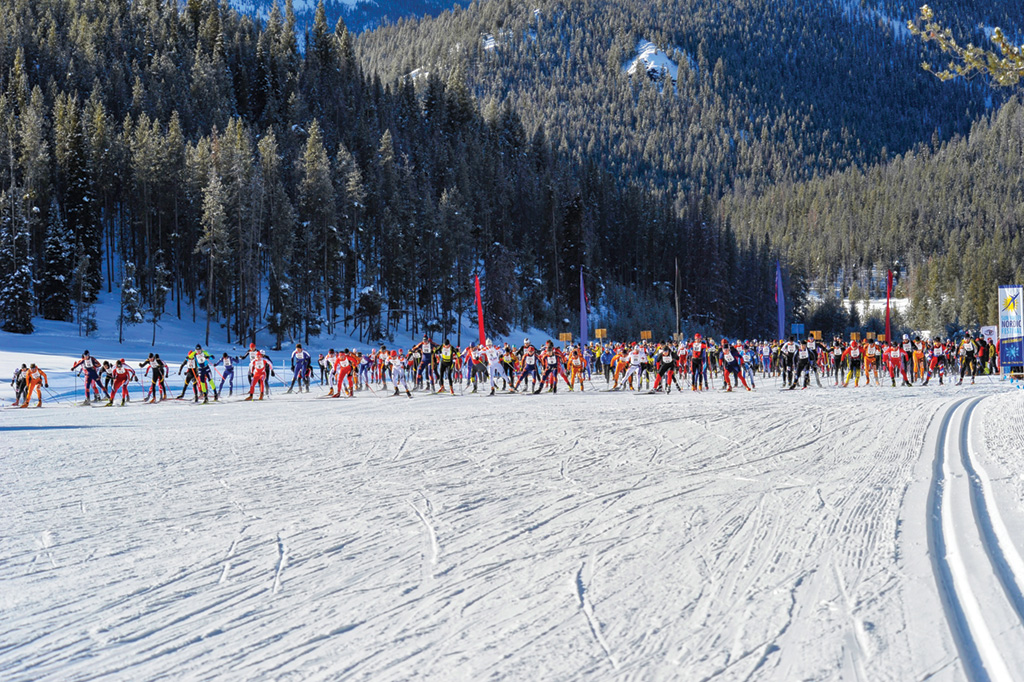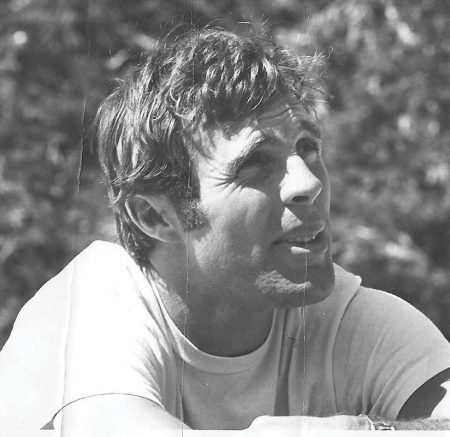Come February 1, 2020, skiers young and old, champions and novices, men, women and children will step up to the starting line of the annual Boulder Mountain Tour held on the Harriman Trail north of Ketchum. There will be colorful ski suits, expertly waxed skis, and plenty of nervous energy to go around. For the BMT, as it is affectionately known, is no cakewalk. It is a 34-kilometer Nordic ski race that includes some of the world’s best athletes. And despite the promise of a morning filled with lactic-acid-induced, screaming-muscle pain and lungs hungrily gulping for air, 1,000 people will show up—likely more would but the number of entrants is capped—as they do every year for this Valley-wide communal rite of passage.
A thousand will ski the competitive 34-kilometer race; hundreds more will opt for the also challenging but, safe to say, more social 15-kilometer event. It is a tradition that draws elite racers, families skiing en masse, and even newcomers to the sport. It is, in a word, a spectacle—a good spectacle—thanks to a skier and coach named Rob Keisel who had a bold idea for a race 48 years ago.
Created by an Icon of Nordic Skiing
Kiesel was among the most influential people in the history of Nordic skiing, including that at Sun Valley. His pioneering innovations in Nordic coaching, team building, trail making, trail grooming, and glide-waxing changed both competitive and recreational Nordic skiing throughout the world. An accomplished alpine ski racer before switching to Nordic, Kiesel moved to Ketchum in 1971, and with a partner opened Snug Mountaineering for backpackers, climbers, and cross-country skiers. It was in the same building in which the outdoor store The Elephant’s Perch now operates.
The following year, Kiesel took over the coaching of a small group of high school Nordic skiers who had been training on Sun Valley’s trails with Swedish Nordic skiing legend Leif Odmark. Kiesel convinced the then alpine-only Sun Valley Ski Education Foundation to adopt a Nordic program.
Bob Rosso (who founded and still owns The Elephant’s Perch and has been one of the primary promoters and organizers of the BMT from the beginning) was Kiesel’s assistant coach. Over the next few years, Kiesel expanded the program and attracted skiers to Sun Valley. A remembrance of Kiesel, who died in October 2011, published in Faster Skier magazine read: “According to Rosso, Kiesel liked to tinker and experiment. He spent time finding new ways to set cross-country track, perhaps most notably along the 32-kilometer Harriman Trail. There in the Wood River Valley, Kiesel helped develop one of the country’s first distance races for cross-country skiers — the Boulder Mountain Tour — in 1973. ‘There were these epic stories of Rob grooming a point-to-point trail with archaic 1970s snowmobile stuff,’ said SVSEF Nordic Program Director Rick Kapala. One of the first to dream up a year-round trail from Galena Lodge to the Sawtooth National Recreation Area (SNRA) near Sun Valley, Keisel had to route the trail. Kapala recalled stories of him driving into the river on his snowmobile.”
High-level athletics was in Kiesel’s blood. His father, Bob, won an Olympic gold medal in 1932 as a member of the world-record-setting, 4×100 meter relay team at the Los Angeles Games.
A Race Is Born
The first BMT from Galena Lodge to the SNRA was 30-kilometers long and crossed State Highway 75 five or six times. The course was mostly either on top of the highway’s snowbank or right next to it. There were 48 competitors in that race and the first winners were Brent Hansen (2:53:15) and Julie Gorton (3:09:30).
Hansen remembers the race like this: “Quite a bit of snow had blown in the night before the race. I was surprised to see how many people were at the start since it wasn’t a big sport in the valley yet. There was a mishmash of wooden skis, synthetic skis, weird touring set ups and probably some Army surplus. It seemed like a large cross section of skiers was there—from young to old. I had been experimenting with ‘klister’ [wax] all season in the backcountry instead of using skins. So that is what I decided to use for the race, thinking it might be warmer on the bottom half.
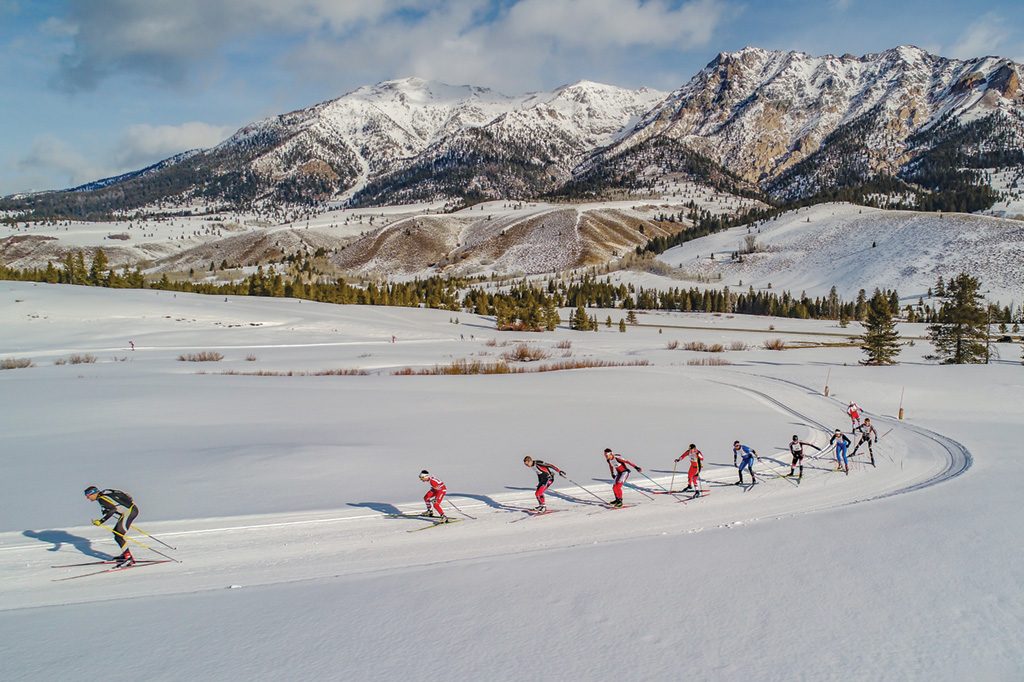
Skiers round a bend with the Boulder Mountains in the background. Photo courtesy Zions Bank Boulder Mountain Tour / Steve Butler.
“When the race started, I immediately iced up with clumps of snow and so was at the back of the pack. I had to run with this on and off for the first half of the race. In the second part, the snow was warming up and I was surprised to see I started passing a lot of people. From Phantom Hill to the finish, the trail was blown in and difficult to find. I finally caught up with the lone skier ahead of me, Hermann Primus, who was much older than me, but going strong. I finally was able to pass him. Then I broke trail the rest of the way and realized how much work Hermann had done for us all! At the finish I was shocked to see that I had won.
“Many town folks had come out to watch and cheer us all on at the finish and along the route. The joy and excitement of the event really helped kick off Nordic skiing in the Wood River Valley where residents were longing for something like this and wanted to ski other places besides Baldy and Dollar.”
The following year, 1974, the winners were Bob Rosso (1:54:30) and Polly Sidwell (2:18:15). The fastest times ever for the 30 kilometer race, which ended in 1998, were by Havard Solbakken in 1:05:34:3 and Heidi Selnes in 1:12:13:2.
In 1999, some changes in the starting area made the BMT a 32-kilometer race, won first by Carl Swenson and Laura McCabe. (The fastest times ever for this course were posted by Brooke Baughman at 1:12:36:1 and Eric Meyer at 1:06:27:6, both racing in the 2003 race.) In 2014, more course alterations were made and bumped the course length to 34 kilometers. The first winners in the 34-kilometer race were Chelsea Holmes and Sylvan Ellefson. The fastest overall times to date were posted in 2018 by Matt Gelso in 1:10:28:4 and Caitlin Gregg in 1:17:41:2.
The Standouts
But there’s much more to the BMT than individual winners in those categories. There is also the 15-kilometer Half BMT that starts at Baker Creek and ends at the SNRA. And there are 14 different age categories: from 13 years and under (12 and under for the Half BMT) to 80- to 84-year-olds. In 2019, the winners in the 13 and under category were Anika Vandenburgh (2:01:52:95) and Holden Archie (1:52:22:27). Anne Trygstad of Bozeman, Montana, won the women’s 75 to 79 category (2:41:57:13) and the lone competitor in the 80-84 age category was Steve Swanson, who finished in 2:45:15:29.
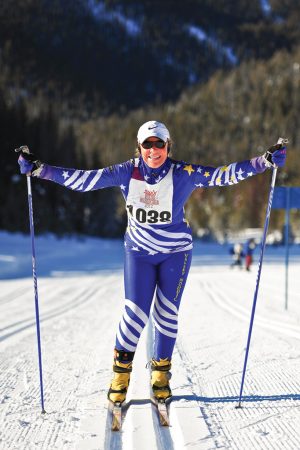
JoAnn Levy competed in every Boulder Mountain Tour between 1964 and 2014. Photo courtesy Zions Bank Boulder Mountain Tour / Nils Ribi.
JoAnn Levy, who first came to Sun Valley from Hawaii in 1964 and who has been a fixture in the Valley ever since, including a stint as mayor of Sun Valley, competed in every BMT through 2014, sometimes winning her age category. That’s 41 consecutive Boulder Mountain Tours. In 2005, BMT organizers gave Levy a special jacket in acknowledgement of her
30 consecutive races (a couple of BMTs were cancelled due to snow conditions).
Dave Bingham, one of the finest outdoor sports athletes in Wood River Valley history, won the BMT twice and placed second two other times in the early to mid-80s before, as he said, “…skate skiing became the go-to technique.” Bingham also placed third in the 1980 Pikes Peak Marathon and in 1988
and 1990 won the NBC “Survival of the Fittest.” Such is the caliber of athlete that contends for the BMT podium spots. Bingham is also one of the best-known, accomplished climbers in Idaho and the author of the best climbing guidebooks to southern Idaho.
Bingham also exemplifies the close interconnection of the BMT and its racers with the young, aspiring skiers at the SVSEF. Kids ski in the races; elite racers coach the kids; ski parents help put on the race, and so it goes. Bingham, for his part, coached at the SVSEF in three stints over 37 years for a total of 28 years of coaching.
Kevin Swigert was director of the BMT for 13 years before retiring at the end of the 2014 season. Swigert, a Twin Falls native who has spent most of his life in the Wood River Valley, was a member of the U.S. Nordic Ski Team and three times National Champion. As director, he was the primary force behind creating the Sun Valley Nordic Festival, which has become a major winter event that coincides with the Tour. The Festival features social events, race clinics, demo days, and an organized ski tour.
The Tour Becomes a Legacy
From 48 racers in 1973, the BMT has grown to where only 1,000 competitors, some of them among the best skiers in the world, are allowed each year. A BMT program from 2014 describes the early years as “…similar to the Boulder Mountain Tour races these days, with the more competitive racers bunched up in front while the recreational skiers enjoyed the scenery and the camaraderie that comes with a slower pace. What was different then was that the racers couldn’t pass easily because of the sketchy grooming. And as for the slower skiers, they really took time to enjoy the day. ‘There were no aid stations back then. We used to bring a backpack with lunch, and sometimes a bottle of wine,’ reminisced Andy Munter, the owner of Backwoods Mountain Sports and a veteran of many Boulder Mountain Tour races. ‘The trail was only set for one day a year, so people really took time to enjoy it.’”
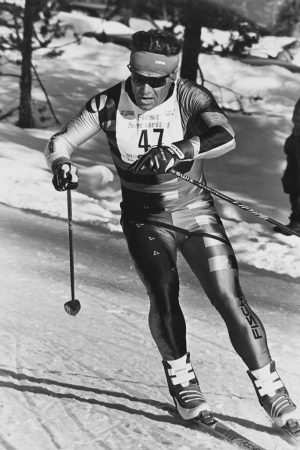
Longtime Boulder Mountain Tour and Nordic skiing supporter Bob Rosso competing. Photo courtesy Zions Bank Boulder Mountain Tour.
Today Sun Valley calls itself “Nordic Town, USA” with over 200 kilometers of groomed trails open to the public from Galena Lodge to as far south as Bellevue. Last season there were nearly 66,000 skier days reported on those trails.
The economic impact of the BMT and recreational Nordic skiing on the community is difficult to precisely measure, but, according to Harry Griffith, executive director of Sun Valley Economic Development, “In 2012, the total economic impact of the nine days of Nordic Fest in February was $3.1 million for Blaine County. The majority of this impact was from visitors who came from across the U.S. for the Boulder Tour and stayed an average of four days to celebrate Nordic skiing.”
That’s a significant legacy to the local community from one man who liked to “tinker and experiment” and find new ways in the world.


